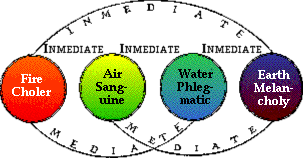The humours (3)
The perfect state for the body is a balance between the four humours, but since the Fall the humors have been in various stages of imbalance with different people.
In the diagram, the humours that are described as "inmediate" can be combined; those "mediate" cannot; thus a personality can be choleric-melancholic, but cannot be choleric-phlegmatic (think about it and you'll see the sense behind the rule).
When the humours are unbalanced, the result is that humans are vulnerable to disease: colds, for example, where the phlegmatic humor is obviously in excess (water dripping from eyes and nose, and phlegm being coughed up); fevers, where choler is excessive, as evidenced by the heat of the brow, and where the sanguine too is predominant, shown by flushed cheeks.
What better way to get rid of an excess of the sanguine humour than by letting blood?
A less distressing prescription*.
Footnotes
-
The water of life
A less distressing prescription would be aqua vitae (brandy -- literally "the water of life") for a cold; aqua vitae was hot and dry (it would burn if ignited, and undoubtedly felt hot as it was drunk).
Those who were inclined to melancholy would be advised to pursue a diet which involved meats, vegetables, and seasonings which were categorized as hot and dry (radish, pepper, and so on).
